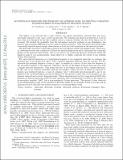Rotationally resolved spectroscopy of asteroid pairs: No spectral variation suggests fission is followed by settling of dust
Author(s)
Polishook, David; Moskovitz, Nicholas; DeMeo, Francesca E; Binzel, Richard P
DownloadBinzel_Rotationally resolved.pdf (1.731Mb)
PUBLISHER_CC
Publisher with Creative Commons License
Creative Commons Attribution
Terms of use
Metadata
Show full item recordAbstract
The fission of an asteroid due to fast rotation can expose sub-surface material that was never previously exposed to any space weathering process. We examine the spectral properties of asteroid pairs that were disrupted in the last 2 million years to examine whether the site of the fission can be revealed. We studied the possibility that the sub-surface material, perhaps on one hemisphere, has spectral characteristics differing from the original weathered surface. This was achieved by performing rotationally-resolved spectroscopic observations to look for local variations as the asteroid rotates. We spectrally observed 11 asteroids in pairs in the near-IR and visible wavelength range. Photometric observations were also conducted to derive the asteroid lightcurves and to determine the rotational phases of the spectral observations. We do not detect any rotational spectral variations within the signal-to-noise of our measurements, which allows us to tightly constrain the extent of any existing surface heterogeneity. For each observed spectrum of a longitudinal segment of our measured asteroids, we estimate the maximal size of an un-detected “spot” with a spectral signature different than the average. For five asteroids the maximal diameter of such a “spot” is smaller by a factor of two than the diameter of the secondary member of the asteroid. Therefore, the site of the fission is larger than any area with a unique spectral parameters. This means the site of the fission does not have a unique spectrum. In the case of an ordinary chondrite asteroid (S-complex), where the site of fission is expected to present non-weathered spectra, a lack of a fission “spot” (detectable spectroscopically) can be explained if the rotational-fission process is followed by the spread of dust that re-accumulates on the primary asteroid and covers it homogeneously. This is demonstrated for the young Asteroid 6070 that presents an Sq-type spectrum while its inner material, that is presumably revealed on the surface of its secondary member, 54827, has a non-weathered, Q-type spectrum. The spread of dust observed in the disintegration event of the Asteroid P/2013 R3, might be an example of such a process and an indication that P/2013 R3 was indeed formed in a rotational-fission event.
Date issued
2014-08Department
Massachusetts Institute of Technology. Department of Earth, Atmospheric, and Planetary SciencesJournal
Icarus
Publisher
Elsevier
Citation
Polishook, D. et al. “Rotationally Resolved Spectroscopy of Asteroid Pairs: No Spectral Variation Suggests Fission Is Followed by Settling of Dust.” Icarus 243 (2014): 222–235.
Version: Original manuscript
ISSN
0019-1035
1090-2643